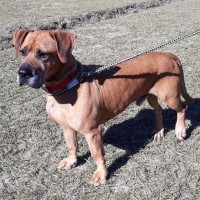Appearance of the Boxer Basset
|
| The Boxer Basset Hound is a long, muscular dog with a large head, short legs, medium-sized muzzle and long, floppy ears. In fact, their large feet and head with their short body make them comical, and some say they look like they were made by gluing bits of other dogs together. Their coat is usually light brown and white, but it can be any mixture of brown and white, black and white or black and brown. The Boxer Basset can also be tricolored with any of these color variations. With their touching looks and amusing waddles, they can make you laugh just by looking at them. |
Temperament of the Boxer Basset
|
| They're great family dogs because they love spending time with people, and are happy to do nothing as long as they're with you. Because of their Basset Hound blood, they can be lazy and just want to hang out, but if they hear you talking about food or play, they usually come running. Although they're intelligent, they can take a little longer to train than most dogs. This could be because they're lazy or just stubborn. They like to pout when they get into trouble, and they can be almost annoying when they want to go out. However, they are also incredibly loving and good-humored dogs. |
Needs and activities of the Boxer Basset
|
| The Boxer Basset can be a lazy dog who just wants to lie around the house when they're not playing or eating. However, to prevent them from becoming overweight, you need to give them at least 45 minutes to an hour of exercise every day. They love to investigate and enjoy sniffing around a trail, so take your Boxer Basset for a hike in your local park or for a walk around the neighborhood. It's best not to encourage them to jump because of their short legs. They tend to develop elbow dysplasia if they exert too much effort on their legs. |
Maintenance of the Boxer Basset
|
| The Boxer Basset's short, hard coat makes it easy to care for. In fact, all they really need is a gentle brushing with a soft bristle brush once or twice a week. This will minimize shedding and promote circulation. Only bathe them when necessary, as this removes the skin oils they need. Brushing his teeth at least once or twice a week will prevent dental problems, and you can trim his nails if necessary. Because they have such long, soft ears, you need to check them often for dirt, debris, wax and mites. Keep them clean by wiping them with a soft cloth or cotton ball. Never use a cotton bud in your dog's ears. This can cause serious damage. |









 English (United Kingdom)
English (United Kingdom)